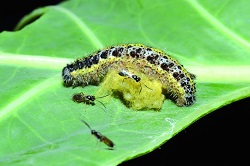Organisms associated with herbivorous insects influence plant responses
Parasitic wasps are described as parasitoids, insects whose eggs and larvae develop inside the body of other arthropods, whereas the adults are free-living. However, under natural conditions, several parasitoid species inject into their hosts not only their eggs but also polydnaviruses (polydisperse-DNA viruses, or PDVs). PDVs are unique insect viruses associated with thousands of parasitoid species in intimate mutualistic symbiosis. The virus benefits from such mutualism as it can replicate exclusively in the ovaries of female parasitoids without expressing virulence. The parasitoid benefits from such mutualism as PDVs suppress the herbivore’s immune response, therefore allowing the parasitoid offspring to develop successfully inside the herbivore. The EU-funded Horizon 2020 project HerbivoreAssociatedOrganisms tested the hypothesis that PDVs alter herbivore physiology and affect plant defences. This change in phenotype may in turn, affect the herbivore’s interaction with the plant. Results indicate that symbiotic viruses associated with parasitoids play a key role in plant-insect interactions. Effect on plant-insect interactions At the molecular level, PDVs are responsible for down-regulation of plant toxins and caterpillar defence-related genes. At the ecological level, the plant phenotypic changes induced by PDVs also affect the behaviour of other insect community members. “The diamondback moth, for example reduces colonisation pressure on plants previously attacked by PDV-infected caterpillars. However, the hyperparasitoid Lysibia nana (a natural enemy developing in other parasitoid species) is attracted towards plants previously attacked by PDV-infected caterpillars,” explains project coordinator Dr Marcel Dicke. The project revealed the remarkable effect of insect symbionts on plant-insect interactions. PDVs were found to affect caterpillar oral secretions and plant defensive responses to the consumption of plant material. “We focused on how HAOs in the form of symbiotic viruses associated with parasitoid wasps, impact the molecular and ecological aspects of plant-insect interactions,” says Dr Dicke. Results suggest that PDVs down-regulate plant chemical defences to the benefit of the parasitoid partners via plant-mediated trophic effects. However, this remarkable effect is associated with an ecological cost. Hyperparasitoids can detect PDV-induced changes in the plant phenotype and exploit them to locate parasitoid victims. Importance in agriculture HerbivoreAssociatedOrganisms’ findings will benefit ecologists working on plant-insect interactions, virologists studying PDVs as well as biologists investigating symbiosis in general. Results highlight the need for placing mutualistic symbiotic interactions in an ecological perspective for the advancement of the field of plant-insect interactions. An integrated approach linking studies on plant-insect interactions with insect symbioses needs to be increasingly implemented in future research. The finding that hyperparasitoids locate their parasitoid hosts via plant-phenotypic changes induced by PDV-injected caterpillars is relevant for the biological control of insect pests. According to Dr Dicke: “It will provide a better understanding of hyperparasitoid foraging behaviour and potentially may be used to lure them away from the target crop, thus supporting sustainable control of insect pests in agriculture.” Understanding the ecology of interactions between plants, herbivorous insects that may be agricultural pests, and their natural enemies such as parasitic wasps is important in the development of sustainable agriculture. Further information can be found at Science online.
Keywords
HerbivoreAssociatedOrganisms, parasitoid, polydisperse-DNA virus (PDV), herbivores, hyperparasitoid

